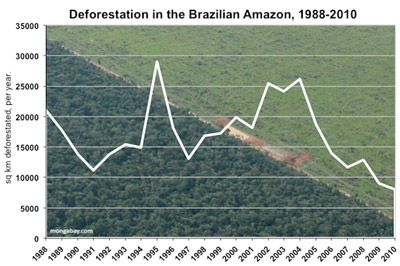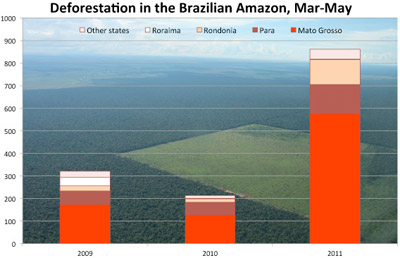Deforestation in the Amazon jumped sharply in some Brazilian states since last year, according to data released in recent weeks by Imazon, a Brazilian NGO that tracks deforestation. Overall deforestation rose 15 percent to 1,532 km2 in the August 2010 through June 2011 period relative to the same months a year earlier, reports Imazon.
According to Brazil’s National Institute of Space Research (INPE), 312 km2 of Amazon rainforest were cleared in June, representing a 28 percent increase in deforestation over June 2010]. However, Imazon recorded only ninety-nine km2 of Amazonian deforestation in June, implying a reduction in deforestation of 42 percent over the previous June, according to Ecodebate.com.
Discrepancies in deforestation data are expected as INPE and Imazon use different satellite modeling systems. In addition, cloud cover varies month to month and limits the effectiveness of satellites. Imazon noted Amazonian cloud cover fell from forty to twenty percent between May and June of this year, increasing detection of deforestation.
 Deforestation has fallen dramatically in Brazil since 2004…  … but there are troubling signs this year that progress has reversed. |
Imazon and INPE both measure deforestation between August and June, when cloud cover is lowest. However, the agencies employ distinct deforestation analysis systems. INPE has used the DETER (Detection of Deforestation in Real Time) analysis since 2004, and forwards the results of DETER’s findings to IBAMA, Brazil’s equivalent of the Environmental Protection Agency in the U.S., on a daily basis. IMAZON developed SAD (Alert System of Deforestation), a system that uses different techniques to detect and map deforestation.
To compile its official annual deforestation statistics, however, INPE uses the advanced PRODES system. Unlike both DETER and SAD, PRODES analyses higher-resolution images and is capable of detecting clearings under 25 hectares. Official annual statistics calculated from the PRODES analysis are considered the most reliable and will be available from Brazil’s National Institute of Space Research (INPE) in October or November.
Despite differences in their estimates, Imazon and INPE agree deforestation rates in the Amazon are increasing. Imazon also notes that forest degradation totaled 6,274 km2 this past deforestation measurement period, a rise of 266 percent over the 2009-2010 data.
Previously, the state of Mato Grosso registered the Amazon’s highest deforestation levels, but the June data—the last monthly data available this year—suggests that Pará, located in the eastern Amazon, has taken the unfortunate lead. According to INPE more than one third of June’s deforestation, 119 km2, occurred in Pará, while deforestation in Mato Grosso fell from 93.7 km2 in May to 81.5 km2 i. While the area deforested was highest in these two states, the rate of deforestation rose most rapidly in Tocantins, reaching 800 percent over 2010 levels.
Imazon estimates Amazonian deforestation released YXZ tons of C02 equivalent between August 2010-June 2011, an increase of 4 percent over the same period a year earlier.
Related articles
Satellite data shows slight increase in Amazon deforestation over June last year
(08/03/2011) Deforestation in the Brazilian Amazon rose 17 percent in June compared to the same period a year earlier, reports Brazil’s National Institute for Space Research (INPE).
Brazilian government: Amazon deforestation rising
(06/30/2011) Satellite data released today by the Brazilian government confirmed a rise in Amazon deforestation over this time last year.
Deforestation in Brazil’s Amazon continues to rise; clearing highest near Belo Monte dam site
(06/17/2011) Deforestation in the Brazilian Amazon continued to rise as Brazil’s Congress weighed a bill that would weaken the country’s Forest Code, according to new analysis by Imazon.

(06/03/2011) As an American I know a lot about shame — the U.S. government and American companies have wrought appalling amounts of damage the world over. But as an admirer of Brazil’s recent progress toward an economy that recognizes the contributions of culture and the environment, this week’s decision to move forward on the Belo Monte dam came as a shock. Belo Monte undermines Brazil’s standing as a global leader on the environment. Recent gains in demarcating indigenous lands, reducing deforestation, developing Earth monitoring technologies, and enforcing environmental laws look more tenuous with a project that runs over indigenous rights and the environment.